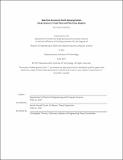Real-time monocular depth mapping system using variance of focal plane and pixel focus measure
Author(s)
Paerhati, Paruku
DownloadFull printable version (1.957Mb)
Other Contributors
Massachusetts Institute of Technology. Department of Electrical Engineering and Computer Science.
Advisor
Kamal Youcef-Toumi.
Terms of use
Metadata
Show full item recordAbstract
Vision is one of the most powerful senses available to creatures. Undoubtedly, many of the fundamental operations of humans, such as the ability to plan paths, avoid obstacles, and recognize objects, depend heavily on their visual perception of the world around them. Although humans have naturally evolved to efficiently use their stereo optical prowess to develop an understanding of their environment, artificial machines and systems in comparison have just begun to utilize computer vision to create awareness of local physical entities. One of the most important sensory skills creatures have is depth perception, which allows them to estimate the relative distance of objects in their vision from many visual cues. Many systems have been developed to aid machines in perceiving the depth map of their environment, and each system has its drawbacks and benefits. In this paper, we introduce the design and implementation of a new system which provides a depth map from the use of a single optical camera with focal plane variation in the images taken. The paper focuses on the methods used to scale the depth from focus algorithm to perform in real-time. The results also showcase a real-time depth mapping system capable of providing rich depth maps of scenes at a high framerate and with advanced noise filtration techniques.
Description
Thesis: M. Eng., Massachusetts Institute of Technology, Department of Electrical Engineering and Computer Science, 2017. This electronic version was submitted by the student author. The certified thesis is available in the Institute Archives and Special Collections. Cataloged from student-submitted PDF version of thesis. Includes bibliographical references (page 48).
Date issued
2017Department
Massachusetts Institute of Technology. Department of Electrical Engineering and Computer SciencePublisher
Massachusetts Institute of Technology
Keywords
Electrical Engineering and Computer Science.